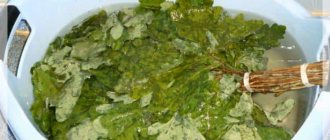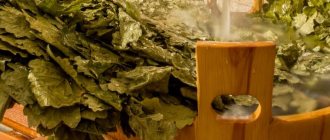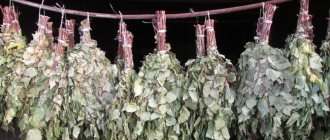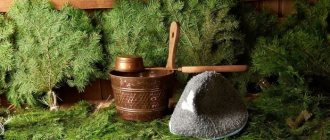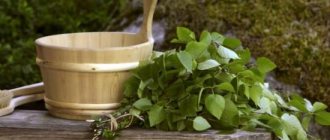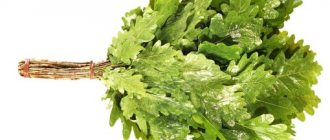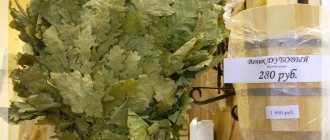A bathhouse without a broom is a waste of money. If you are well acquainted with this principle, but do not know (or do not remember) how to soak a broom for a bath made of oak, birch, spruce and other trees, it does not matter. Now we will quickly fill the gap in your knowledge, and you will be able to steam with knowledge and confidence in the future.
It's no secret that visiting a steam room has a beneficial effect on the human body. There he can relieve accumulated stress, warm up his body to prevent colds, cleanse his skin and just have a good time.
- FAQs How to properly steam in a sauna with a broom: a detailed guide A sauna is one of the best ways to bring yourself to life.
At the same time, a high-quality broom is an integral attribute in all bath procedures. It can be birch, oak, eucalyptus, juniper, alder, fir, and this is just the beginning. It is believed that each broom has its own special properties, so knowledgeable bath attendants choose bundles based on the purpose of visiting the steam room.
So, it’s time to figure out how to properly steam a bath broom and which one to choose best.
Why do you need to steam a broom at all?
Obviously, a massage with a dry and hard broom will be more reminiscent of medieval torture than a pleasant and healing procedure. At least for this reason, bath brooms should always be steamed.
Moreover, the process of steaming a broom is necessary so that its leaves begin to release the maximum amount of essential oils, resins and other useful elements to the human body. Also, thanks to this, the steam room space will be enveloped in a pleasant aroma of natural wood, which has a positive effect on the respiratory system.
Plus, a bath broom with softened and elastic branches will have all the necessary massage properties, as well as have a beneficial effect on the skin, improve blood circulation, promote sweating and perform other functions.
What types of bath brooms are there?
To figure out which broom is right for you, you need to familiarize yourself with their types and properties. Usually all brooms are divided into three categories:
- Deciduous (birch, alder, linden, oak, ash, and so on);
- Conifers (pine, spruce, juniper, fir, etc.);
- Herbal (from nettle, wormwood, mint and others).
For example, birch brooms are an all-time classic due to their strength, flexibility and practicality. They are not only very convenient to use, but also have a beneficial effect on human skin and quickly absorb sweat.
Another favorite of many bath attendants is an oak broom with even greater strength and wear resistance. With its help you can quickly create intense steam in the bathhouse and thoroughly warm up the body of the person steaming.
Another popular broom is the eucalyptus broom. Thanks to its properties, the steaming process with it turns the sauna into one large inhaler. They prefer to use it to clear the airways and “throw away” a cold. However, its branches are quite thin, so you can often find combined brooms with eucalyptus, birch or oak.
Essential oils of pine brooms also help to breathe properly in the steam room, however, for massage purposes, these tools may not be suitable for those who have sensitive skin or a fear of pine needles. Nevertheless, they are preferred by fans of more “hardcore” steaming.
Nettle brooms are considered an effective prevention of gout, radiculitis and diseased joints. In addition, they have a beneficial effect on human skin. However, nettle brooms are not as strong as oak, birch and even coniferous brooms. Therefore, they are also sometimes combined with other branches.
- FAQs Is it possible to go to the bathhouse if you have a cold: we answer the main question of all times and peoples. Usually it is asked after the questions “what to do?” and “who is to blame?”
Sometimes brooms made of maple and wormwood are taken to the bathhouse, but they are not as widespread as the above options. Maple has antiseptic properties, improves the skin, and also tones and relieves pain in the body.
Wormwood brooms are not suitable for everyone due to their specific smell, but their use helps relax muscles, relieve nervous tension, eliminate headaches and improve sleep.
About birch: short but succinct
Birch is remembered as the heroine of an old Soviet joke, when the Decree of the Council of Ministers of the USSR ordered an order of magnitude increase in the production of birch sap, not only clarified, but also with pulp, in the next five-year period. But seriously, birch supplies raw materials for many sectors of the national economy. Let's list the most widely known areas of application:
- The birch tree supplies sap. The preparation of the exquisite elixir from the Soviet Union was on a grand scale and in Soviet grocery stores it was the most affordable at a price - 8 kopecks for a standard Gost glass. By the way, tomato went for 10 kopecks, apple for 15, grape for 18 - 20. The top of the hierarchy was pomegranate, the price of which varied widely depending on the region. A significant disadvantage of birch sap was considered to be that it was not customary to drink it with alcohol. The tomato one was more popular, the difference in price was only 2 kopecks, but it also successfully replaced a snack;
- A lot of sports equipment was made from birch. Starting from spears, athletics discs and ending with skis. In the latter role, maple was a serious competitor to birch;
- The handles of hammers, mallets, and file handles were made of birch wood. First of all, due to the excellent density, homogeneity of the wood and its peculiar elasticity, which is very useful in the tools listed above;
- Birch plywood and veneer are a kind of classic of the genre. Birch furniture, at one time, was very popular in Scandinavia and Finland;
- If we already remembered the Finns, then how can we not remember the famous Finnish printing, which was done on coated paper, the raw material for which was the pulp of birch trees;
- Birch was used to make wooden components for Kalashnikov assault rifles;
- Only birch was used to make spools of thread;
- It has also found application in aviation. During the Great Patriotic War, elements from the wood of this tree were used for non-essential parts of the airframe kit of some aircraft;
- After all, she supplied “bursak porridge.” Flexible and durable rods of young growth were considered throughout the Russian Empire to be an excellent educational and preventive pedagogical tool, the moderate use of which significantly increased discipline and academic performance in primary and secondary educational institutions.
What about the bathhouse? There is also more than enough birch in the bathhouse. Let's count:
- Birch firewood. They are highly valued for their good calorific value and unique mild aroma. Due to the fairly high density and humidity, they require long-term drying under natural conditions. As a rule, the time for complete drying takes from 14 to 18 months. Birch logs are very good for open fireplaces in the dressing room. Smooth, soft flame, few sparks, beautiful bluish color of the flames. Significant disadvantages of birch firewood include their viscosity and difficulty in splitting. Of course, small-scale mechanization tools help to significantly alleviate procurement issues and alleviate the severity of the problem. The second significant negative point is the tendency to form soot plugs in chimneys, especially when raw wood and birch bark are used as firewood.
- Matches. Every time you light a fire in a sauna stove, you need to pay tribute to this light wood, which massively provided, and still provides, the raw material needs of match factories. By the way, birch bark is very convenient and practical for heating a stove.
- Birch beer mugs. Due to the fact that the wood of this tree is very dense and homogeneous, it is well suited to manual and mechanized processing, including turning. Birch beer mugs are very popular in Germany. It is considered especially chic to serve light wheat in a liter mug with birch bark. We have already talked in detail about how this foamy drink and a bath are associated.
- Finally, brooms. Perhaps the most popular and famous use of birch in the history of human civilization.
How to steam a bath broom made of birch, oak, eucalyptus and other trees?
There are several simple and universal ways to steam a bath broom. The main thing is to follow several recommendations before any of them:
- Before the steaming process, the broom must be thoroughly rinsed in cold water;
- It is also worth making sure that its leaves are not limp, spoiled or completely rotten;
- If the broom is completely new, it is not necessary to steam it. Before use, just dip it in warm water for a while.
Method number 1. Half an hour
So, let's move directly to the steaming methods. The first method is used some time before bath procedures.
First, you need to dip the broom into a bucket of heated water and leave it there for 25 minutes. After this time, add hot water to the container, cover it with something and wait no more than ten minutes.
Then you can take out the steamed broom, shake off excess water and begin the procedures.
Tips for preparing a birch “bouquet”
Before “brewing” a broom for a bath, it is important to prepare it correctly. This is done in advance, because birch branches, unlike oak branches, can be cut in a short period of time. General recommendations for preparation:
- birch branches growing in a clean place, far from railways, highways, and industrial enterprises are suitable for bathing procedures;
- raw materials are harvested in the summer, from early June to mid-July, until catkins appear on the tree;
- the rods are cut in dry weather, in the morning, after the dew has disappeared;
- it is advisable to choose a young tree that has not yet bloomed;
- Long side branches that grow closer to the ground need to be trimmed.
You can read more about the rules for preparing and storing quality sauna attributes in a separate article.
Method number 2. The fastest
For those who are in a hurry to whip themselves and others with a broom in the steam room, there is the simplest and very fast way to do this. Simply dip the tool in hot water for a few minutes, then take it out and get to work.
Of course, experienced bath attendants do not particularly welcome this approach, but it is used by many people who do not see bath procedures as a sacred ritual.
Conclusion
In the video presented in this article you will find additional information on this topic. Also, based on the text presented above, we can conclude that preparing and working with a broom is a real ritual to which bath attendants attach special importance. At the same time, there is nothing complicated in this process, and for lovers of this type of relaxation, it can become a unique way to receive aesthetic pleasure (find out here which stones are best for a bath).
Did you like the article? Subscribe to our Yandex.Zen channel
Method number 3. Optimal
This method is used by most steamers and considers it the most optimal. First, the broom is dipped in warm and then in hot water (for about 20 minutes). After this, the bundle is shaken off and wrapped in a plastic bag.
Before starting the bath procedures, take the broom out of the bag, rinse it again, steam it over hot stones for 30 seconds and begin the procedures.
Physics in the steam room
The heated air in the steam room rises up to the ceiling. There the temperature is above 80-90 degrees. It’s cooler on the middle shelf, and the floor can feel cold from the frozen soil. The layers of air remain motionless. In the bathhouse, brooms are used to push hot air from under the ceiling toward the body.
The strongest steam room lovers climb to the top shelf. There a person warms up so much that he can plunge into the snow or an ice hole. Classic vaping involves gradually warming up the muscles. The procedure ends with a massage with brooms.
Method number 4. Time-consuming
If you still have a long time before your bath procedures (8-10 hours), you can use this method of steaming a broom and you won’t go wrong.
To begin, take a broom and completely lower it into a deep container with cool water. After 30 minutes, you need to shake it a little, turn it over and leave it there until you attend the procedure.
Just before entering the steam room, the broom must be taken out of the water, wrapped in a wet cloth and placed on the bottom shelf for about ten minutes. Thus, its branches will remain elastic and retain all the essential oils.
Method number 5. Standard
This method is used several hours before visiting the steam room. The broom should be immersed in a previously prepared container with warm water and left for half an hour. At this time, it must be turned over periodically so that the leaves can be saturated with moisture.
After this, the bundle must be removed and immersed again in the container with the handle down. So you need to keep it in the water for another ten minutes, and then boldly go to the steam room.


